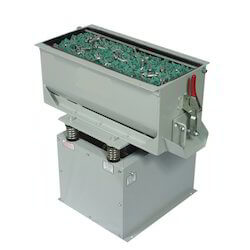Keeping in mind, ever-evolving requirements of our valuable clients, we are offering an exclusive range of Polishing Vibrator Machine. This machine is to be loaded with suitable steel media and component to be processed when the motor rotates. Our range of these machines are designed for giving optimum results and are suitable for any royal metal ornaments like gold, silver and bronze. The offered machine is manufactured using high grade raw materials and latest technology in compliance with international standards. Our esteemed clients can avail this machine at competitive prices.

A polishing vibrator machine, also known as a vibratory polishing machine or vibratory tumbler, is a device used for surface finishing and polishing of various types of materials, including metals, plastics, and stones. It is commonly used in industries such as metalworking, jewelry making, automotive, and manufacturing. The machine utilizes a vibrating motion combined with polishing media to achieve a smooth and polished surface finish on the workpieces. Here are some key features and considerations of a polishing vibrator machine:
Vibrating Motion: The machine consists of a bowl or chamber that vibrates at high frequency, causing the polishing media and workpieces to move in a circular or tumbling motion. This motion enables efficient and uniform polishing of the workpieces by creating friction and contact between the media and the surfaces.
Polishing Media: Polishing vibrator machines use a variety of polishing media, such as ceramic media, plastic media, or stainless steel media, depending on the desired finish and the type of material being polished. The media particles, along with a polishing compound or abrasive, help remove surface imperfections, burrs, and provide a desired level of shine.
Variable Speed Control: Many polishing vibrator machines offer variable speed control, allowing operators to adjust the vibration intensity and speed according to the specific polishing requirements. This feature provides flexibility to achieve different levels of surface finish and accommodate various types of workpieces.
Media Separation System: To separate the workpieces from the polishing media after the polishing process, the machine may include a media separation system. This can involve a sieve, screen, or other mechanisms that facilitate the removal of the media while retaining the polished workpieces.
Water and Compound Management: Some polishing vibrator machines have provisions for adding water and polishing compounds to enhance the polishing process. Water acts as a lubricant and cooling agent, while the compound aids in achieving the desired level of shine or surface refinement. These machines may have built-in systems for water and compound circulation or require manual addition.
Size and Capacity: Polishing vibrator machines come in various sizes and capacities to accommodate different workpiece sizes and quantities. Small benchtop models are suitable for jewelry or small parts polishing, while larger industrial-grade machines can handle larger components or higher production volumes.
Noise and Vibration Control: Vibratory polishing machines can generate noise and vibration during operation. Some machines feature noise reduction measures, such as sound-dampening materials or covers, to minimize noise levels. Additionally, anti-vibration mounts or pads may be used to reduce the transmission of vibrations to the surrounding environment.
Safety Features: Safety considerations are important when operating a polishing vibrator machine. This may include safety interlocks, emergency stop buttons, and protective enclosures to prevent accidents and ensure operator safety. Operators should also wear appropriate personal protective equipment (PPE) such as gloves and eye protection when using the machine.
When selecting a polishing vibrator machine, factors such as the type of material being polished, the desired surface finish, the size and quantity of workpieces, and the production requirements should be considered. Consulting with manufacturers or suppliers of polishing equipment can help in choosing the right machine and polishing media for a specific application.
